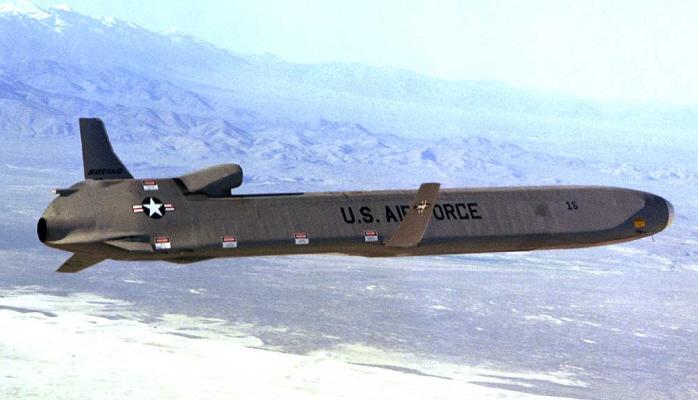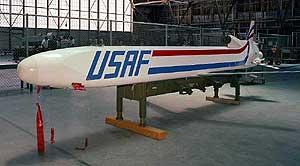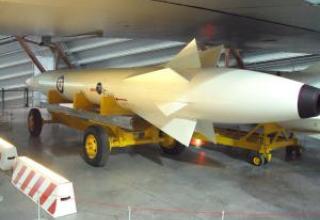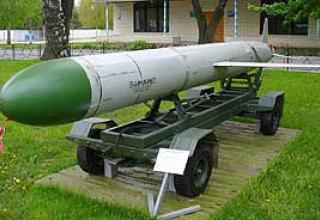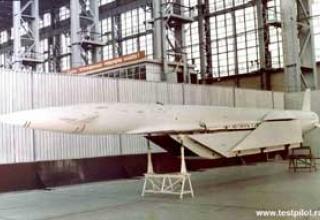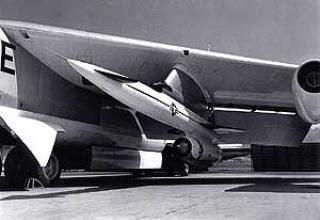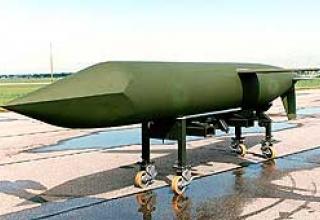AGM-86B cruise missile is designed to engage stationary including highly defended ground targets: ICBM launch pads, command posts, industrial and administrative centers of the enemy. Full-scale development of the long-range air-based cruise missile, designated AGM-86A, under the ALCM ("Air-Launched Cruise Missile") program began in July 1973. In February 1974, Boeing Corporation was selected as the main contractor on the subject. The first launch of AGM-86A took place in March 1976, in September of the same year the rocket with a fully functional control system was launched. In January 1977, it was decided to start full-scale production of AGM-86A missiles.
However, as early as 1977, the JCMP ("Joint Cruise Missile Project") was launched, within the framework of which it was decided to develop an improved long-range air-based missile based on AGM-86A, which was designated AGM-86B. One of the main goals of the JCMP project was also the maximum unification of advanced cruise missiles developed for the U.S. Air Force and Navy. To equip surface ships and nuclear submarines of the U.S. Navy, Raytheon developed the BGM-109A Tomahawk cruise missile. During the implementation of the JCMP program it was decided to equip the BGM-109A and AGM-86B missiles with a single system of trajectory correction on the image of the terrain AN/DPW-23 of McDonnell Douglas Corporation and a unified small-size dual-circuit jet engine F107-WR-100 of Williams. In addition, there was a partial unification of thermonuclear warheads of future CDs - both missiles were equipped with modifications of BC W-80. The first launch of AGM-86B was in August 1979.
In 1979-1980. The U.S. Air Force held a competition, for which two missiles were submitted - AGM-86B of Boeing Corporation and AGM-109 of Raytheon ("air" modification of BGM-109A "Tomahawk"). Despite the fact that the creators of AGM-109 put forward a more advanced concept of placement of missiles on board the B-52G bomber, according to which the aircraft took on board up to 18 CR AGM-109 (12 missiles on two underwings and 6 in the bomb compartment on a multi-position rotating launcher) against 12 CR AGM-86B on two underwings, the victory in the competition was given to the AGM-86B missile corporation "Boeing".
Onboard equipment of strategic bombers B-52G "Stratofortress", which were to become carriers of AGM-86B, was modified under the OAS ("Offensive Avionics System"). Later, B-52H aircraft were also converted to new missiles. In 1981-1990, 195 vehicles were upgraded (99 modifications G and 96 modifications H). For the first time, new missiles were deployed on B-52G 416 heavy bomber wing SAC U.S. Air Force (Griffith Air Force Base, New York), whose aircraft began to carry the combat duty with the KR AGM-86B in December 1982. In 1988-1993, all B-52H bombers received the CSRL ("Common Strategic Rotary Launcher") intra-fuselage multi-position rotating launcher, which allowed to increase the combat force of one aircraft to 20 missiles (it was decided not to convert older B-52Gs). In September 1991, by order of President J. Bush Sr. all strategic bombers (including those equipped with ALCMs) and air tankers that served them were removed from permanent combat duty. Regular flights of bombers with AGM-86B missiles in combat gear were stopped in September 1992. The missiles were taken into active reserve and are listed in the "nuclear stand-off".
AGM-86B missiles were planned to be equipped with supersonic strategic bombers "Rockwell" B-1B "Lancer", which began to be delivered to combat units of the U.S. Air Force SAC in July 1985. All 100 bombers produced were equipped with hanging units and could carry up to 20 AGM-86B (12 on the outer and 8 on the inner suspension). However, the test program, which began in November 1987, for various reasons, was never completed. In 1996, following the acquisition by these aircraft of the capability to use high-precision non-nuclear weapons, the specialized suspension units and equipment intended for nuclear weapons were dismantled and these machines were removed from the so-called "nuclear offsets".
A total of 1,715 AGM-86B missiles were fired and their mass production was discontinued in October 1986. In June of the same year Boeing Corporation started research under the CALCM ("Conventional ALCM") program, aimed at creating an ALCM with non-nuclear propellant. The new modification was designated AGM-86C (CALCM Block 0). In order to save money, it was decided to retrofit some of the existing AGM-86B missiles. When replacing the thermonuclear BC with a shrapnel-phase missile mass has increased markedly, which caused a significant reduction in flight range. The main difference between AGM-86C and its predecessor was the control system - the trajectory correction system for the AN/DPW-23 terrain image was removed and instead of it the GPS satellite navigation system was installed, which significantly increased accuracy.
The AGM-86C reached combat readiness in January 1991, which allowed the U.S. Air Force to use it in Iraq during Operation Desert Storm. The missiles, the official existence of which was discovered only in 1992, were developed under the Senior Surprise program. The operation to use the missiles was called "Secret Squirrel". Seven strategic bombers B-52G Stratofortress from the 2nd heavy bomber wing (Airbase Barksdale, Louisiana) took off with a partial load (on board there were 39 SLCMs with a potential to place 84 missiles). Thirty-five of the 39 missiles were successfully fired at targets in Iraq, after which the aircraft returned to the base. The flight was non-landing, with numerous refuelings in the air.
In 1996, a new modification of AGM-86C missile was adopted for service, which received the designation CALCM Block I. The missile received a heavier and heavier shrapnel-phase BC and an improved control system - the satellite navigation system receiver became multichannel. All previously launched Block 0 missiles have been upgraded to Block I. CALCM Block I missiles were widely used during the NATO military aggression against Yugoslavia.
In 1998, the development of another modification of CALCM - Block IA began. In January 2001, the new missile went into service. The missile has an improved receiver satellite navigation system, which provided better accuracy and resistance to interference, in the memory of the BCVM can store multiple routes to the approach of the ALCM to the target, which improves the effectiveness of the missile when flying over desert or sharply rough terrain. All CALCM missiles have been converted from previously launched AGM-86B missiles. CALCM missiles launched before 2001 received Block IA level onboard electronics without changing the designation already available. The new missiles were used during operations against Afghanistan and Iraq.
The last modification of the CALCM version to date is AGM-86D (CALCM Block II), which made its first flight in November 2001. CALCM Block II is equipped with a penetrating AUP ("Advanced Unitary Penetrator") designed by Lockheed Martin and is designed to destroy deepened and fortified targets.
The only carrier of all available modifications of the CALCM ALCM (as well as AGM-86B) - strategic bomber Boeing B-52H, it is planned to remain in service with the U.S. Air Force until 2030.
Composition:
AGM-86B (C,D) SQWB is made according to the normal aerodynamic scheme (monoplane), has a complex quadrangle-shaped body with a fairing of the head part (ogival shape for CALCM), folding and recessed into the body of the low arrow-shaped wings in the central part of the body and arrow-shaped folding vertical plumage in the tail of the fuselage. The air intake is mounted in the tail of the missile above the fuselage and is foldable. The hull is made of strong aluminum alloys 2219 and 7050, thermoplastic P-1700 and radio transparent materials. To reduce radar visibility, a special coating is applied to the hull, wing and stabilizer.
The warhead W-80-1 (weight 123kg, length about 1m, diameter 0.27m) with a selective power option of 150ct or 5ct serves as a combat unit of the AGM-86B strategic missile defense system. The warhead is designed by specialists of Los Alamos National Laboratory. It is detonated by a contact fuse. The destruction zone radius is 3 km. The high firing accuracy and considerable power of the thermonuclear warhead allow to hit heavily protected small targets with high efficiency. According to American experts, the probability of destroying a protected object that can withstand an excess pressure of 70 kg/cm2 of one SLBM is 0.85 (Poseidon-C3 SLBM - 0.10).
The CALCM AGM-86C Block 0 missile is equipped with a 900 kg shrapnel-phase BC. CALCM AGM-86C Block I/IA missiles are equipped with a more powerful non-nuclear shrapnel and blast furnace ballistic missile weighing 1450 kg, which has further reduced the flight range. CALCM AGM-86D missile is equipped with a non-nuclear penetrating BC weighing 540 kg.
The AGM-86B ALCM control and guidance system is a combination of the following subsystems:
- inertial P-1000 developed by Litton.
- TERCOM ("Terrain Contour Matching") trajectory correction systems AN/DPW-23 by McDonnell Douglas Corporation
The inertial subsystem (11 kg weight) of control operates at all sections of the missile's flight. It includes an on-board digital computer, an inertial platform and a barometer altimeter. The inertial platform consists of three gyroscopes to measure the missile's angular deflection and three accelerometers. The system provides the determination of the missile's position with an accuracy of 800 m in 1 hour of flight. Up to separation of the ALCM from the aircraft carrier is updated data in the inertial subsystem of the missile control system by coordinates of the current location and altitude of the flight. The role of the leading system in this process is played by the inertial control system of the launch vehicle.
The TERCOM-correlation subsystem operates in the middle and end sections of the missile's flight. It includes a computer, a radio altimeter, a set of reference maps of areas along the route of the missile. The beam width of the radio altimeter is 13-15°. The frequency range is 4-8 GHz. The principle of operation of the TERCOM subsystem is based on comparing the terrain of a specific missile location with reference maps of the terrain along the route of its flight. The terrain is determined by comparing data from radio and barometric altimeters. The former measures the altitude to the ground surface and the latter relative to sea level. Information on a particular terrain is entered digitally into the on-board computer, where it is compared with data on actual terrain and reference maps of areas. The computer provides correction signals for the inertial control subsystem. The stability of the TERCOM subsystem and the necessary accuracy of the cruise missile location is achieved by selecting the optimal number and size of cells, the smaller their size, the more accurate the terrain and, therefore, the location of the missile. However, due to the limited memory of the on-board computer and the short time required to solve the navigation task, the nominal size of 120 x 120 m was adopted. The entire route of the cruise missile flight over land is divided into 64 correction areas of 7-8 km long and 0.8-2 km wide. The adopted quantitative characteristics of the cells and correction areas, according to American experts, ensure that the cruise missile can reach its target even when flying over flat terrain. The permissible error of the terrain height measurement for the reliable operation of the TERCOM subsystem should be 1 m.
On CALCM missiles of all modifications, the AN/DPW-23 system was removed and replaced by the Interstate Electronics' GPS satellite navigation system, which allowed for a significant increase in accuracy. Starting with CALCM Block I, the satellite navigation system was continuously upgraded and the inertial control subsystem was upgraded. Correspondingly, the accuracy of firing was also increasing.
The AGM-86B rocket is equipped with a small-size turbojet twin-shaft F107-WR-101 engine from Williams (see photo) with a low degree of dual-circuitness and mixing of the flows of both circuits in the nozzle. Fuel - JP-9.
Bombers B-52H are equipped with rotary launchers CSRL (see photo) and allow to place on board up to 20 missiles AGM-86B - in the bomb bay 8 missiles on the CSRL, and 12 missiles on two pylons under the wings. Each pylon can carry 6 CSRs (see photo) and is docked to the B-52 aircraft's suspension unit located between the fuselage and the engine's inner pylon. The weight of the pylon is 2270 kgf. After the start of all KR pylons can be dropped to reduce the frontal resistance of the aircraft.
According to the requirements of the OSV-2 contract, for the purpose of identification by means of space reconnaissance, the wings of B-52G CR carriers (some of the existing B-52G carriers were converted into CR carriers) were equipped with small decorative surges in the root part ("strakelets"). B-52H CR carriers were not equipped with such flows, as all existing vehicles of this modification were CR carriers, and to distinguish B-52H from B-52G with the help of space reconnaissance means was not very difficult.
Characteristics:
| Range of fire, km | 2780 (1200 for CALCM Block I/IA) |
| Missile launch weight, kg | 1450 (1950 for CALCM Block I) |
| The rocket's flight speed is average, km/hour. | 805 |
| Rocket speed maximum, km/h. | 1200 |
| KVO, m | 90 (30 for CALCM Block 0, 10 for CALCM Block I, 3 for CALCM Block IA) |
| Weight BC, kg | 123 (900 for CALCM Block 0, 1450 for CALCM Block I/IA, 540 for CALCM Block II) |
| Maximum rocket body diameter, mm | 620 |
| The length of the rocket, mm | 6320 |
| Wingspan, mm | 3660 |
| Engine traction F107-WR-100, kgf | 272 |
| Weight of dry engine, kg | 64 |
| Engine length, mm | 1232 |
| Diameter of the motor, mm | 305 |
Testing:
Evaluating the results of the combat application of "Maverick" missiles with TV homing heads in Vietnam (A "Ì-65A), during the operation "Desert Storm", during flight tests and training launches (A "Ì-65A and A "Ì-65B) specialists note that these missiles have quite high accuracy. According to their calculations, the probability of a guided missile hitting a small target (tank, APC, etc.) was 85% on average. However, it is emphasized that such an indicator was achieved under favorable conditions (only during the day and with good visual visibility of the target), in which it is possible to use guided missiles with TV homing heads. This imposes great limitations on the use of missiles in Central and North European theaters of war, especially in winter, due to a significant reduction in daylight hours, frequent fogs and precipitation. Therefore, it is only possible to effectively use guided missiles with television homing heads during this period in 30% of daylight hours.
Sources:
- To defend and deter: the legacy of the United States Cold War missile program / J.C. Lonnquest and D.F. Winkler. USACERL, 1997.
- Alert operations and the Strategic Air Command, 1957-1991 / SAC HQ Office of the Historian, 1991.
- Strategic Air Command and the Alert program: a brief history / SAC HQ Office of the Historian, 1988.
- SAC Missile Chronology 1939-1988 / by Office of the Historian HQ SAC. OH HQ SAC, Offut AFB, NE, 1990.
- Стратегические бомбардировщики и ракетоносцы зарубежных стран / В.Е. Ильин и И.В. Кудишин. Москва, АСТ Астрель, 2002.
- В.Кожевников "Крылатые ракеты для вооружения самолетов", - Зарубежное военное обозрение, N6 1999; N3,4,5,6 2000; N3 2001.
- Василенко С.И., Новичков Н.Н. Программы разработки и производства крылатых ракет в США.// Техническая информация. ОНТИ ЦАГИ. 1982г.
- http://www.dodmedia.osd.mil
- www.strategic-air-command.com
- www.nuclearweaponarchive.org
- www.globalsecurity.org
- www.fas.org
- www.designation-systems.net
